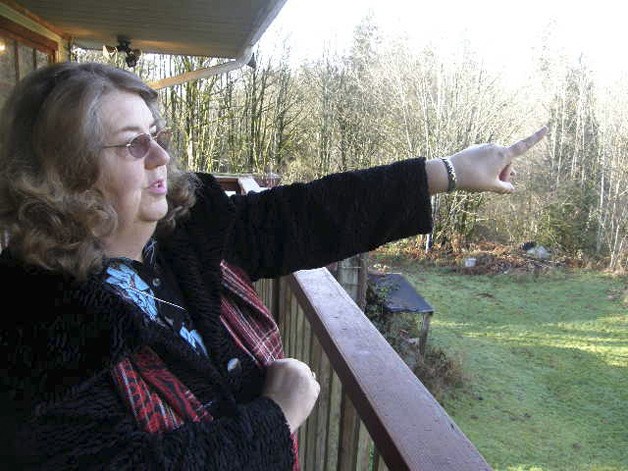Jason Fiorito’s grandfather opened a track in 1960 east of Auburn to give local high school kids an alternative to public streets and roads to race their cars.
Grandad’s original track added muscle over the years, the track morphing into Seattle International Raceway in the 1960s and back to Pacific Raceways, its original name, in 2002. Today, the facility hosts more than 300 events each year, including drag racing, sports car, motorcycle, club and vintage car races.
Jason Fiorito, today president of Pacific Raceways, doesn’t believe that’s enough any longer. He believes it’s time to upgrade Pacific Raceways, so it can meet professional motor sport sanctioning body requirements and once again, host significant racing events just like it did in the 1960s and ’70s.
He has said the upgrade will generate millions of dollars in sales tax revenues for King County and create thousands of jobs.
Of course, not everybody feels expansion is a good idea. From the back porch of the home they have lived in since 1953 on Auburn-Black Diamond Road, Ruth Lundberg and her daughter, Sandy Gaither, can see not only nearby salmon bearing Soos Creek but also the track’s grandstand up the slope about a half-mile away.
And they can certainly hear the noise. These track-to-jowl neighbors say the roar of the engines is already so loud on some racing days they can’t hear each other talk in their own house. And if Fiorito is allowed to host races up to seven days a week, as he intends, he will not only drive them out of their heads but also out of their home.
“If he is allowed to build that, this house will be basically unlivable,” said Lundberg.
Supporters and foes of the expansion will have a chance to speak up at a public hearing before the King County Transportation and Environment Committee at 9 a.m., Tuesday in the King County Council Chambers in Seattle.
At issue is not the actual master development plan but a proposed ordinance that would create a special district overlay called a “Regional Motor Sports Facility.” Applying only to Pacific Raceways, it would allow plans to proceed on the 327-acre site one-quarter mile off Highway 18.
Fiorito did not return calls seeking comment.
But the ordinance lays out plans that call for a road course, a shifter kart course, a motocross course, a 5/16th-mile oval track and up to two drag strips. It would allow retail and wholesale sales, automotive repair, service and storage, a fire station, a service station, a driving school, daycare, manufacturing, restaurants and concessions, and extraction of dirt, sand and gravel in conjunction with the construction of racing surfaces.
The ordinance also:
• Does not require landscaping but allows construction in vegetative buffers, “only if the buildings are shielded from view of adjoining residential properties” to the “maximum feasible extent.”
• Allows construction on steep slopes, but only if necessary to “bring racing surfaces into compliance with applicable racing association safety standards,” and only if Fiorito provides the county with geotechnical data and appropriate mitigation measures to ensure slope stability.
Don Huling, a retired engineer who lives about a mile away from the track, said the proposed ordinance would grant Fiorito special rights that no one else gets. Who else, Huling asks, gets to build on or remove trees from steep slopes, or fill in wetlands? Who else in King County gets to ignore the Critical Areas Ordinance? Why is he being allowed to do his development plan piecemeal when it is supposed to be completed as a whole? And what’s with the part that says there will be no environmental review for 10 years, even though protected salmon will be spawning on raceway property and the Soos Creek Fish Hatchery is just downstream?
“And for 10 years, we can’t say a thing about it,” Huling said.
What it adds up to, Huling added, is a very sweet deal for Fiorito, courtesy of King County.
“Money talks,” said opponent Karen Meador.
Neighbors say they had no knowledge of the expansion plans before Leah Boehme, who owns a pottery business on Auburn-Black Diamond Road, in September discovered what was going on and sounded the alarm. By that time, the proposed ordinance was six months old and things were well advanced.
“I have lived here for years and never complained about the track, never said a thing,” Boehme said.
“Part of our concern is the lack of transparency, the lack of openness for community participation in any way,” said Meador. “We would never have known if Leah hadn’t found out about it.”
According to examiner.com, at the first public meeting on the ordinance, which took place in October at Green River Community College, Fiorito said it was economically unworkable for him to follow the strictures laid down by the conditional use permit, which demand that he post five “quiet non-racing weekend days per season and to have non-racing events on Monday and Tuesday each week that would create no noise to affect the neighbors. He said that the track has done the same thing for more than 30 years, without any problems because King County Department of Development And Environmental Services officials agreed to allow nonimpacting muffled” vehicles on quiet days.
According to examiner.com, Fiorito added that, though he sympathized with the frustration of neighbors, if he weren’t allowed to run the track every day during the season from May until October and had to limit activities on Monday and Tuesday, Pacific Raceways and the driving school that uses the track on those days would lose too much money and be forced out of business.
Said Boehme: “If he wants a first-class racetrack, fine, but we want a first-class environment.”


